Improper storage, contact with corrosive media, lack of care - any of reasons can contribute to the deterioration of the appearance of the tables silverware. But they need to be tidied up as soon as dark spots appear, since white precious metal items are often family heirlooms. Choosing the way to clean up silver spoons at home. Additionally eliminate causes of blackening.
Causes of silverware darkening
Silverware contain a ligature. These additives improve the properties of objects, since the precious metal is not initially resistant to wear and hardness. Due to auxiliary components silver lasts longer, it can be used for silverware production. But it is these additives that affect the appearance of objects. Common causes of darkening of spoons and forks containing Ag:
- silver alloy composition: except for silvered steel products, often used spoons, forks 925, which means the presence in the composition of the ligature (7.5%), including copper, it is this component contributes to the patina (patina of a different color, often - dark);
- careless storage: silverware in most cases is used irregularly and not very often, so gilding (if any) does not rub off, but silver can darken over time, which happens when it is stored for a long time in a humid environment where oxidation occurs due to contact with moisture and interaction with substances that contain water, so it is important to keep silver away from sinks, hoods, and bathtubs;
- improper washing of dishes: often more aggressive cleaning agents and abrasive scrapers are used to remove dried dirt, which is a mistake because it contributes to the damage to the silverware surface and the formation of patina;
- reaction with foods: oxidation occurs if you use cutlery made of precious metal for dishes containing eggs, fish, onions, mayonnaise and milk.

Many people mistake melchior for silver. However, there is a significant difference. So, melchior only externally resembles silver, but differs in composition (contains nickel, copper, less often add iron). This metal also tends to darken over time, which is additionally misleading.
Top 15 best ways, what and how to clean silverware at home quickly and effectively from blackness
You can take your silverware to a professional jeweler, but this is not always possible, which means it is better to choose a few appropriate methods on the basis of improvised means. Cosmetics, stationery, products, etc. should be considered. First you need to test the work of the substance on a hidden area (closer to the edge on the back side) to find out what the result of the new products will be. But first it is necessary to prepare the dishes - to remove the grease. It is soaked in hot water (+50 ° C) for half an hour, adding liquid soap or shampoo.
Polishing with gel toothpaste
A gel-like children's paste is used. It does not contain strong components, abrasive particles. It is prepared:
- rags (flannel);
- toothpaste - the amount corresponding to 1-2 peas;
- toothbrush;
- clean water.
Instructions:
- It is necessary to apply a small amount of toothpaste on a rag. You can use tooth powder instead, but it should be pre-moistened with water to make a paste.
- Rubbing spoons and forks. On areas where there is an ornament, additionally use a brush, because the paste will not get into the micro crevices in any other way. In addition, you can not remove it from there, too, using a rag.
- Products need to be washed with water.
Important: After cleaning the silver, regardless of the chosen method, you need to wipe the items dry, because the surface during drying in the natural method leaves traces of drips.
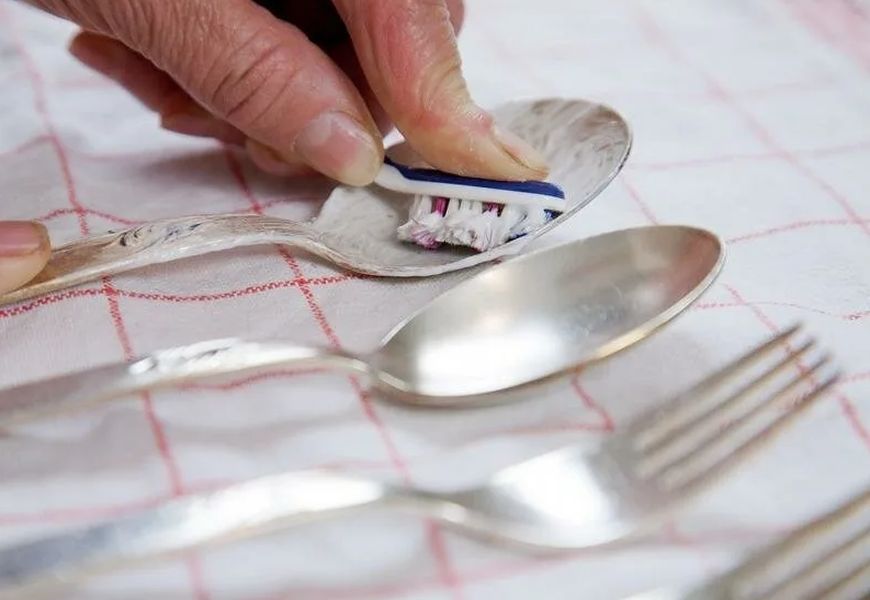
Laundry detergent
To clean silverware, you can also use a detergent. But after using it, you need to rinse the spoons and forks for a long time to remove the invisible film that leaves the detergent. Preparations:
- pot;
- foil;
- powder (any brand).
When to clean silverware at home as much as possible quickly and efficiently, you should use this method.
Instructions:
- Put foil on the bottom of the pan.
- Pour boiling water (the liquid should cover the cutlery).
- Pour the powder, it must be shaken to dissolve.
- Dip blackened silver forks and spoons into the pot.
- After 1 minute, take it out, wash it with clean water.
Liquid for cleaning mirrors
It is necessary to inspect the items. If they have only small pockets of blackening, they can be removed in a simpler way - with a rag. Complex stains are removed in another way. But first you need to prepare:
- a cloth (a flannel cloth will do);
- window/mirror cleaner;
- A container, its volume should be large enough to hold spoons and forks.
Instructions:
- The rag is soaked in the product.
- Remove stains by rubbing these places with a rag.
- If the silver is completely darkened, it should be left in a container filled with a cleaner for cleaning mirrors.
- After 1 minute, the products can be rinsed under water.
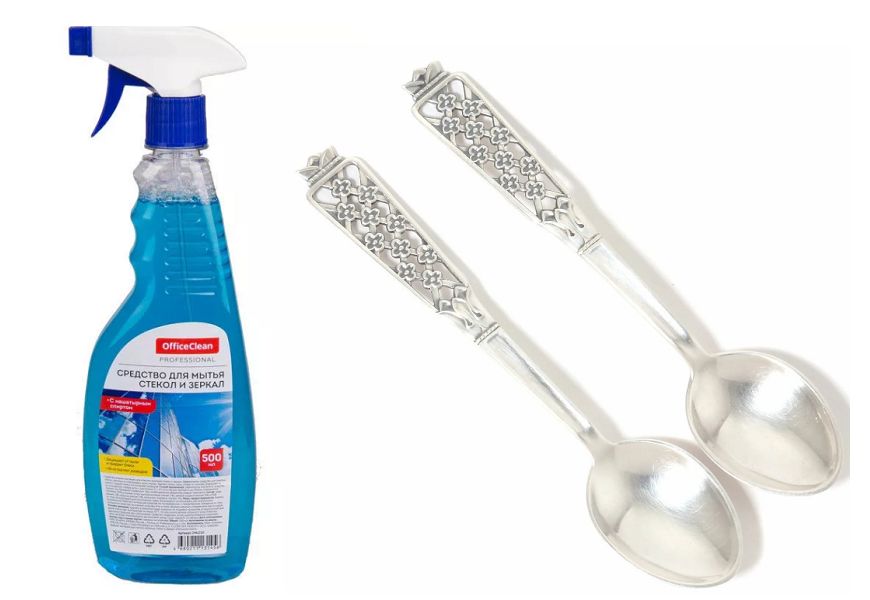
Hand sanitizer
Choosing how to clean silverware in the at homeTo make sure that it shinyThe first ones to be considered are the alcohol-based remedies. A sanitizer can be used for this purpose. It contains alcohol and other components. In order not to spoil the silverware, it is necessary to check the effect of the substance on the metal. If there is no unpredictable reaction, you can apply the hand sanitizer to a rag, and then rub the spoons, forks where there is a patina. This method is chosen when the dirt is weak, and the main problem is the lack of shine.
Cleaning with a stationery eraser
Not knowing how to clean silver spoons in the absence of the usual household remedies, turn to the original methods. At the head of this list is an eraser. It is enough to rub the surface where the blackness. But the method has disadvantages:
- low efficiency of care for cutlery with a complex pattern on the handles (an eraser will not remove dirt from the areas where the surface is embossed);
- Do not use if the spoons and forks are gilded.
Chalk powder
You can clean silver with a chalk-based paste. To perform the procedure you will need:
- 1-2 bars of chalk (depends on the number of dishes);
- mortar;
- capacity;
- rags.
This is one safe way to remove dark spots that occur over time.
Instructions:
- Bars of chalk need to be crushed. Use a mortar or other object. If it is not at hand, you can put the chalk in a bag, hit it several times with a hammer.
- A small amount of water is added.
- Apply the paste obtained on a rag, begin to rub it in, using moderate force.
- Cutlery should be carefully washed under running water, as there may be traces of chalk.
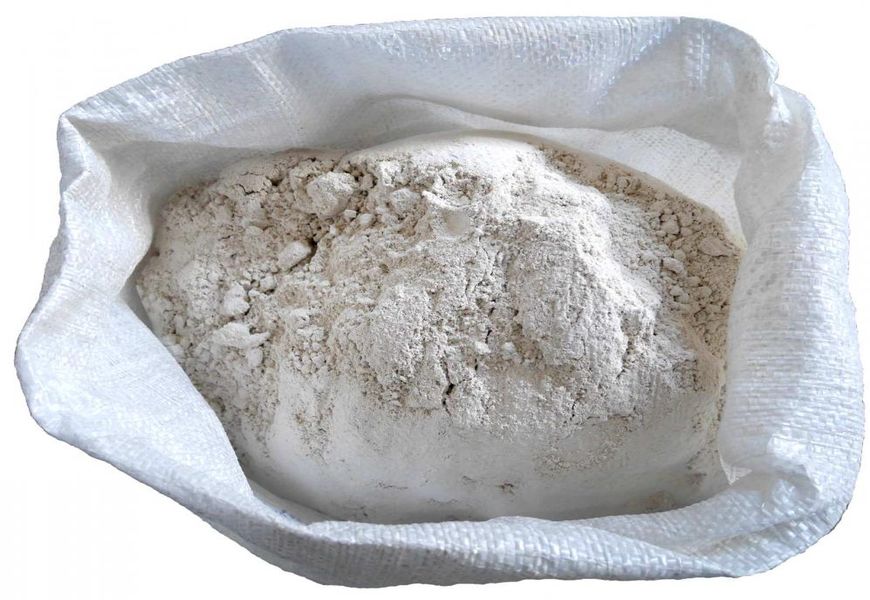
Lipstick
The method is effective, but there are many subtleties in its application
- use lipstick, not lip gloss;
- Apply only to smooth silver, otherwise the greasy lipstick will get caught in the gaps from which it will be difficult to remove;
- The use of lipstick that has expired requires increasing the exposure time to 10 minutes;
- method will not work if you need to clean silver-plated.
Instructions:
- Pomade is applied to the rag.
- Spread evenly over the surface.
- Leave for 5 minutes, then remove the lipstick with a clean cloth.
Soda and foil duo
One quick way to clean silver spoons is a combination of baking soda and aluminum foil. After the procedure, the cutlery will be clean and a shine will appear. Preparations:
- soda - 2 tbsp;
- water - 500 ml;
- foil;
- capacity.
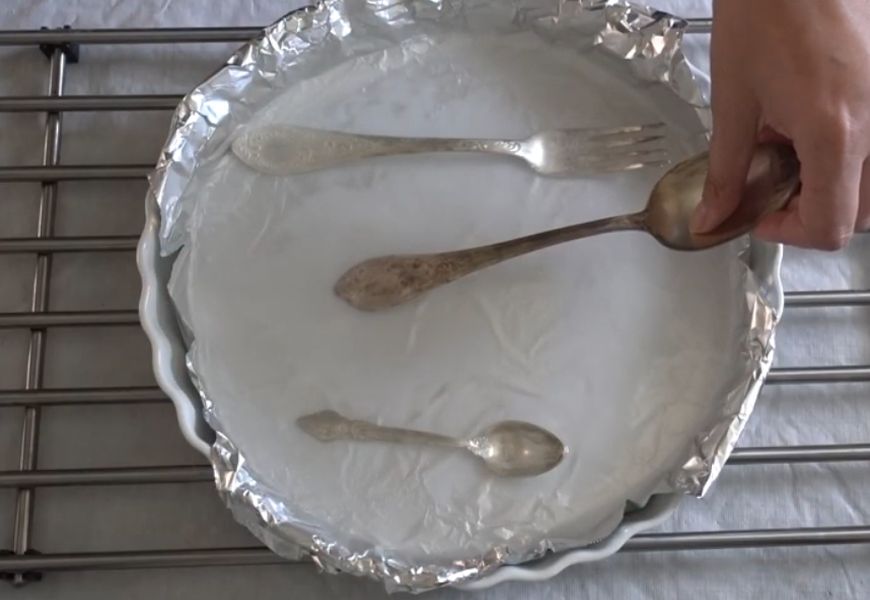
If the silverware to be cleaned is large enough, it is recommended to increase the number of components, taking into account the proportions.
Instructions:
- Boil water in a pot.
- Dissolve soda.
- Put aluminum foil on the bottom.
- Throw silverware. It is important that the water covers them completely.
- After 15 minutes, you can take out the spoons and forks, after which they rinse with tap water.
Porridge of soda
Soda is an abrasive agent. It consists of microparticles, each of which damages the surface during cleaning. Preparing a pulp allows you to slightly reduce the level of negative effects. To do this, you need to mix baking soda with water. The output is a paste, which should not spread. It is applied to blackened silver. In areas where there is a pattern, it is acceptable to use a toothbrush (soft and medium soft). In the last step, simply rinse the silverware with water.
Acid exposure
Lemon juice is used. It is used without any additives, so it is enough just to apply a few drops on a rag. Then use a rag to wipe the items until they shine. Remove the remains of the juice can be removed with clean water. To achieve the best effect, perform reciprocating movements. It is not recommended to use citric acid, as it is more aggressive and can deteriorate the appearance of silverware.
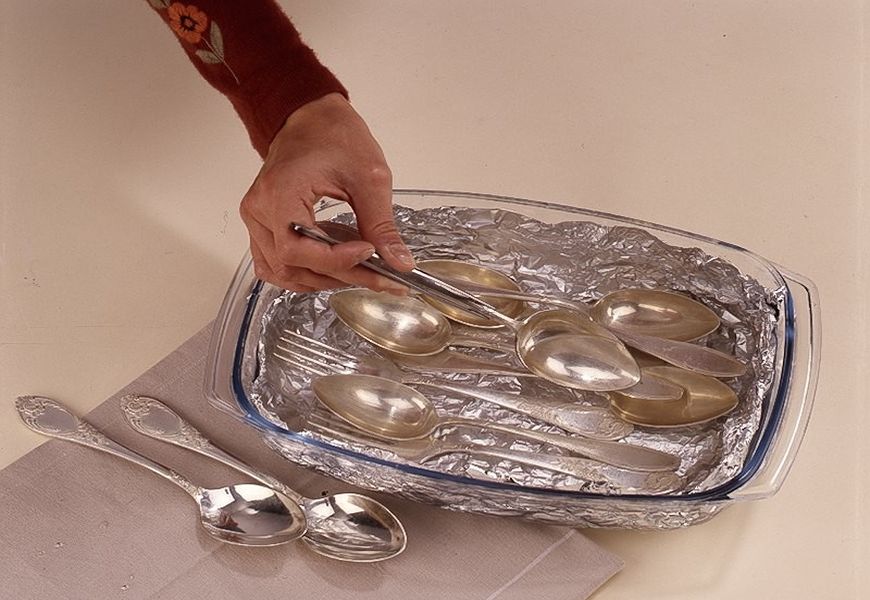
Soda and salt
The solution removes very weak dirt. Its main function is to return silver to luster. It is prepared for:
- 400 ml of liquid;
- salt and baking soda - 2 tsp;
- pot.
Prescription:
- First they boil the liquid.
- Dissolve the main components.
- Leave silverware in the prepared solution.
- After 20 minutes, the liquid is drained and the container is washed.
- Products are rinsed with water.

Soaking in raw potatoes or broth
It is acceptable to use the method if the silver is uncoated, including blackening. Grind the potatoes to the size of shavings. It is necessary to immerse the instruments in the mush. There is also an alternative way to clean silverware - with the help of potato decoction:
- Take the water left over from boiling potatoes.
- The remedy should be brought to a boil.
- When the solution cools down, throw spoons, forks made of silver at the bottom of the container.
- You need to wait two hours, and then you can take out the products.
- They are washed, but already in clean water.
Egg yolk
The method is one of the oldest, but has retained its relevance, because it helps to create an invisible protective film on the silverware. To perform the cleaning procedure, all you need is 1 chicken yolk and a lint-free rag. Instructions for use:
- Prepare the yolk: it must be removed from the shell, properly separated from the white, so that the substances do not mix.
- Applied with a rag on spoons, forks.
- After a few minutes, you can remove the layer of yolk by rinsing the instruments with water.
Coca-Cola
The drink contains enough aggressive components to remove almost any dirt from various surfaces. To restore the original properties of silverware, soak all spoons and forks in the drink. The duration of exposure varies, depending on the complexity of the dirt. Often a few minutes is sufficient.
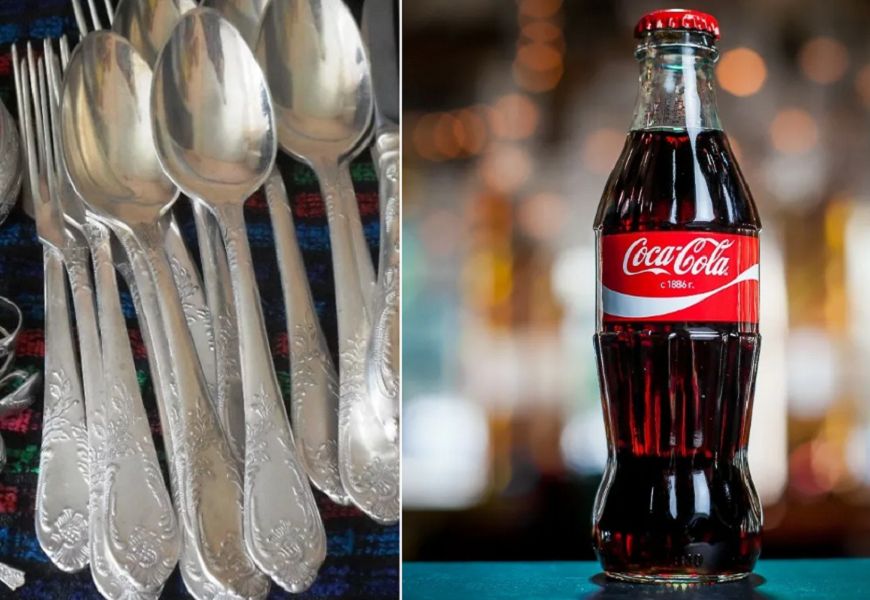
Soap solution
To clean silver spoons at home, household soap is used. It should be grated to form fine shavings, this will speed up the preparation of the solution. When the soap is mixed with water, you can dip the spoons and forks in it. Weak stains are removed after a brief soaking. Difficult stains should be helped to disappear: a rag is rubbed over each item until the dirt is removed. When choosing a method for cleaning silverware, keep in mind that a metal scraper should not be used.
How to clean silver spoons with colored enamel
Any coating can be damaged if abrasives are used. So, when it comes to caring for spoons and forks, you need to determine the type of coating. By comparison, niello and the application of enamel are two techniques that can improve the appearance of objects. But mechanical action will spoil the result (scratches will be left on the silver). It is recommended that you proceed with caution, avoiding the area where the enamel is applied if possible.
Video: how to clean silverware with foil and baking soda
Semi-professional cleaning with GOI paste
There are four varieties of a product called GOI paste. It is a universal method that allows you to clean the surface and polish it at the same time. All 4 types of paste are similar in composition and differ in the size of the abrasive particles. The choice is made according to the soiling of the cutlery. The principle of application is simple: apply the paste to a rag and rub the items until a perfect result is obtained.
It is possible to increase the glide of the abrasive and at the same time increase the efficiency of polishing by adding a small amount of machine oil to the product.
The cost of professional device cleaning
It is possible to buy silverware, which belongs to the category of special care. The average cost is 200 rubles. In especially complicated cases, it is necessary to take the cutlery to a jeweler. But the price in this case is determined individually, since the degree of contamination is always different.
When silver care products are used, you should be aware that they can provide different results. This is due to the different composition of the silver alloy (the minimum allowable Ag content is 75%).
What not to do with silverware
When precious metal spoons and forks are left lying around or misused for long periods of time, it can have negative consequences. These items will be difficult to use. You should not perform the actions:
- wash in the dishwasher: dishes are exposed to the negative effects of aggressive detergents, in addition, exposure to extreme temperatures, their differences are undesirable;
- leave it dirty for a long time: you cannot clean spoons and forks in the standard way, you will have to use aggressive means, which is not recommended, because silver can be spoiled in this way;
- abrasives: particles and other hard inclusions damage the surface, oxidation will occur even faster in these areas.
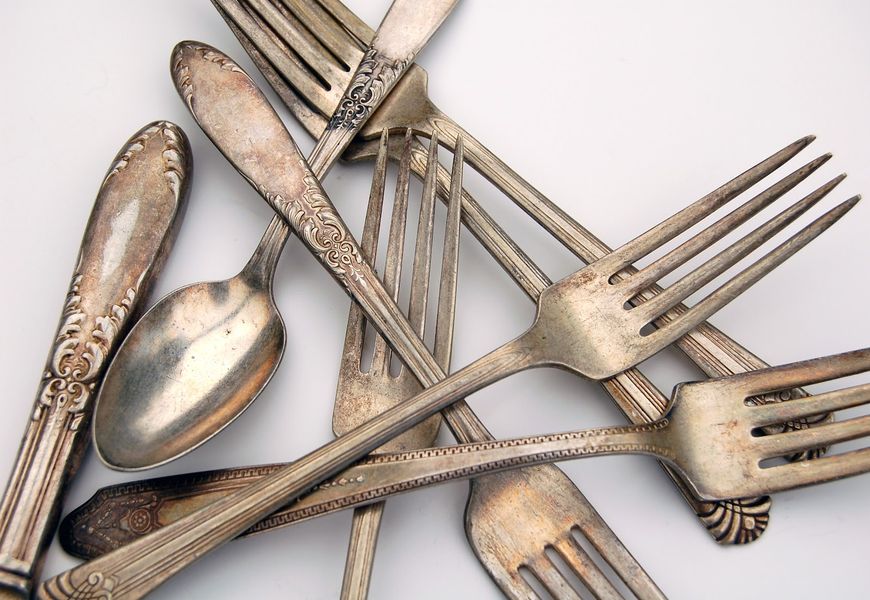
Rules of storage, washing and use
Recommendations that allow you to keep cutlery of silver (including those with gold plating):
- After cleaning, items should rest for at least 3 days until a protective film has formed;
- Store items in a case with a velvet or other woven lining inside;
- Keep devices away from water sources, and the humidity level in the room should be normal;
- A prophylactic cleaning should be performed from time to time;
- You cannot use such devices for certain foods (eggs, mayonnaise, fish, etc.).
Video: how to clean silver spoons with gilding and enamel by yourself
Reviews
I have silverware in my sideboard, in a closed box, with velvet inside. It is a beautiful set, but we have never used it. The color of the metal is still white, even though it has been 10 years since I was handed this box.


According to my observations, silver loses color when exposed to aggressive substances (concentrated vinegar, other acids). I ruined a box of beautiful spoons and knives and forks that way. Since then, I tell everyone not to repeat my mistakes.
I have been cleaning silverware with chalk for years. Always helps, although sometimes there are streaks. I advise to wash the items after cleaning in plenty of water.

Jeweler's comment

